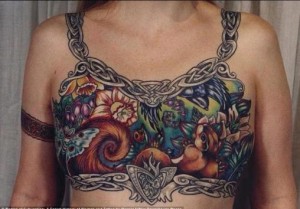 Guest post by Olivia Banner
Guest post by Olivia Banner
I’ve been thinking a lot about Angelina Jolie’s New York Times op-ed (“My Medical Choice”) because I include a section on breast cancer when I teach Literature and Medicine for pre-med students. In her piece, Jolie reveals that she underwent a double mastectomy after testing for the BRCA1 gene; she had reconstruction and implants too.
In my class, we read poet Audre Lorde’s Cancer Journals: she too underwent a double mastectomy but had no follow-up surgeries, and she criticizes the assumption that every woman will immediately want reconstructive work and implants. Lorde recounts a visit by a health care worker, who assumed Lorde would want implants and who encouraged Lorde – for the sake of her emotional heatlh – to get them. Lorde refuses the treatment, and she is very clear that within that encouragement lurks a culture that values women according to their desirability, and that assumes a woman’s emotional health will be influenced by how well she fits into cultural norms for appearance. Lorde’s story often surprises my students: many of them too assume all post-mastectomy women must want implants.
It is especially interesting to hear students respond to the health care worker’s visit, as they come to terms with what this scene reveals: many medical professionals have internalized this way of valuing women, and such encouragement reinforces cultural expectations for bodies, without actually addressing real health concerns (such as the high rate of complications after reconstruction and implant surgeries).
Many people called Jolie’s revelation brave: for some people there was bravery in undergoing the arduous surgeries themselves; for other people, it was brave of a woman whose career depends partly on her breasts to reveal that she’d had them removed. Yet perhaps the even braver choice would have been, like Lorde, to refuse reconstructive surgery and implants. To what extent, I wonder, did Jolie’s physicians encourage her this decision? This may seem a silly question — again, after all, her career has been built on her physical attributes. But it’s an important question for women generally. (A follow-up article in the New York Times stated that in fact many women feel pressured by physicians to get larger implants.
One of the issues I ask students to examine throughout our Literature and Medicine course is whether certain assumptions that we’re socialized into — assumptions regarding norms of appearance and behavior — might make it hard for them, once they’re physicians, to see the alternatives to standard treatments that patients might wish to pursue.
We examine how people make art out of their post-mastectomy bodies, through chest tattooing and other visual works, so that students can consider other ways to conceive what makes a body beautiful. What else should we be looking at?
